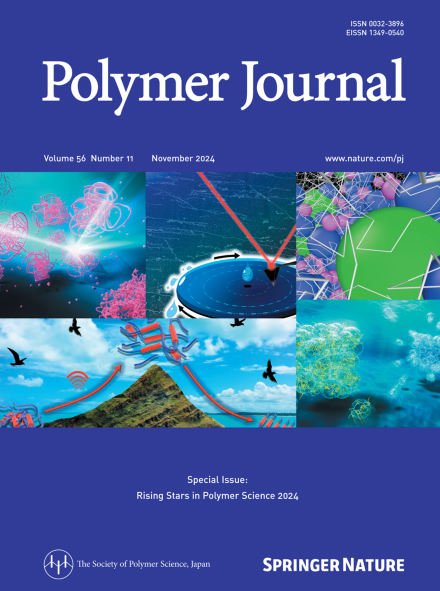非化学计量对环氧树脂物理性质的影响
IF 2.7
4区 化学
Q3 POLYMER SCIENCE
引用次数: 0
摘要
胺通常倾向于在用胺固化的环氧树脂界面处发生析出。为了更好地了解粘合剂界面的聚集状态和物理性质,我们研究了环氧树脂和胺的非均衡比例固化环氧树脂的交联结构和物理性质。随着过量胺的增加,胺不仅以未反应单体或低分子量孤立链的形式留在交联结构中,还形成了悬链末端,增加了固化环氧树脂的异质性。因此,交联密度和质量密度降低,玻璃化转变温度也随之降低。另一方面,杨氏模量随着胺的过量而增加。广角 X 射线散射实验与分子动力学模拟相结合发现,过量的胺抑制了固化反应过程中苯基之间距离的扩大,这表明胺可以在变形过程中起到立体阻力的作用。研究还考察了在非化学计量比条件下用胺固化的环氧树脂的交联结构和物理性质。随着过量胺的增加,部分胺不仅以未反应单体或低分子量孤立链的形式留在交联结构中,还形成了悬链末端。因此,交联密度和质量密度降低,玻璃化转变温度也随之降低。另一方面,由于苯基之间的距离扩大受到抑制,杨氏模量随着胺用量的增加而增大。本文章由计算机程序翻译,如有差异,请以英文原文为准。

Off-stoichiometry effect on the physical properties of epoxy resins
Amines generally tend to segregate at the interface of the epoxy resins cured with amines. To gain better insight into the aggregation states and physical properties at the adhesive interface, we examined the cross-linking structure and physical properties of the cured epoxy resins with an off-stoichiometric ratio of epoxy and amine. As the excess amine increased, the amine not only remained as unreacted monomers or low-molecular-weight isolated chains within the cross-linking structure but also formed dangling chain ends, increasing heterogeneity in the cured epoxy resin. As a result, the cross-linking density and mass density decreased, along with a reduction in the glass transition temperature. On the other hand, Young’s modulus increased with the excess amount of amine. Wide-angle X-ray scattering experiments, in conjunction with molecular dynamics simulations, revealed that the excess amine suppressed the widening of the distance between phenyl groups during the curing reaction, suggesting that this could act as steric resistance during deformation. The cross-linking structure and physical properties of epoxy resins cured with amine under off-stoichiometric ratio conditions were examined. As the excess amine increased, some of the amine not only remained as unreacted monomers or low-molecular-weight isolated chains within the cross-linking structure, but also formed dangling chain ends. As a result, the cross-linking density and mass density decreased, as did the glass transition temperature. On the other hand, Young’s modulus increased with the excess amount of amine due to the suppression of the widening distance between phenyl groups.
求助全文
通过发布文献求助,成功后即可免费获取论文全文。
去求助
来源期刊

Polymer Journal
化学-高分子科学
CiteScore
5.60
自引率
7.10%
发文量
131
审稿时长
2.5 months
期刊介绍:
Polymer Journal promotes research from all aspects of polymer science from anywhere in the world and aims to provide an integrated platform for scientific communication that assists the advancement of polymer science and related fields. The journal publishes Original Articles, Notes, Short Communications and Reviews.
Subject areas and topics of particular interest within the journal''s scope include, but are not limited to, those listed below:
Polymer synthesis and reactions
Polymer structures
Physical properties of polymers
Polymer surface and interfaces
Functional polymers
Supramolecular polymers
Self-assembled materials
Biopolymers and bio-related polymer materials
Polymer engineering.
 求助内容:
求助内容: 应助结果提醒方式:
应助结果提醒方式:


